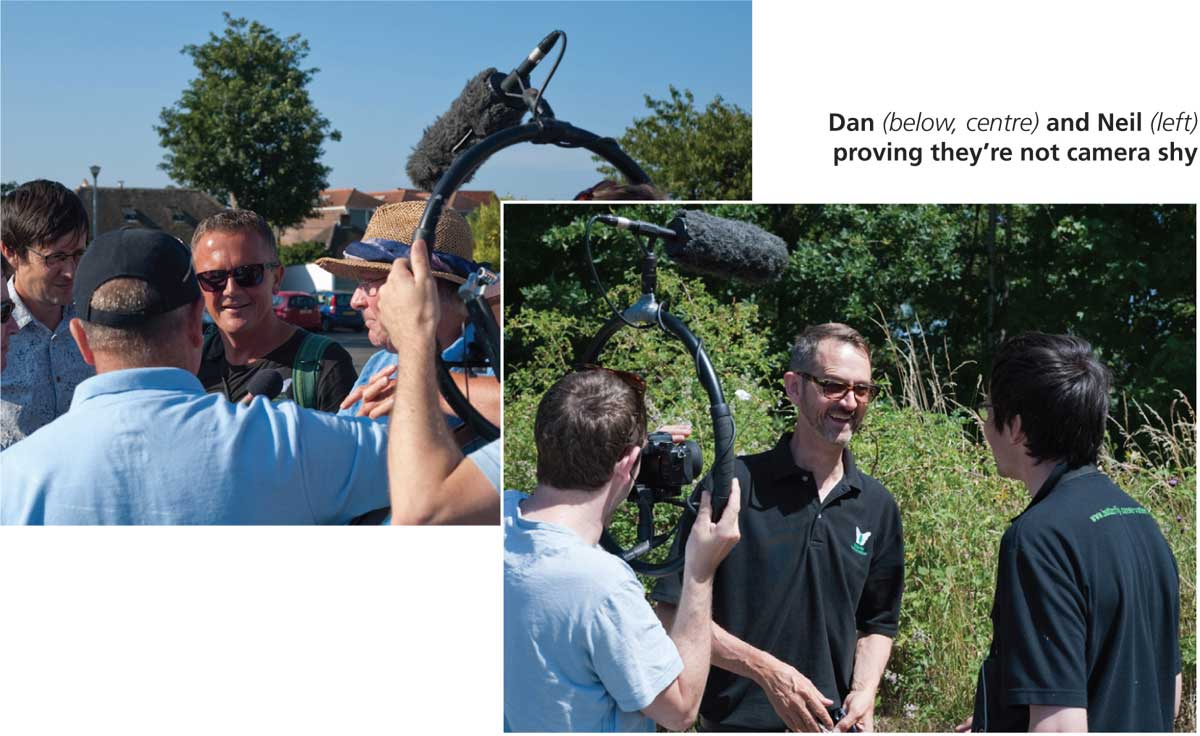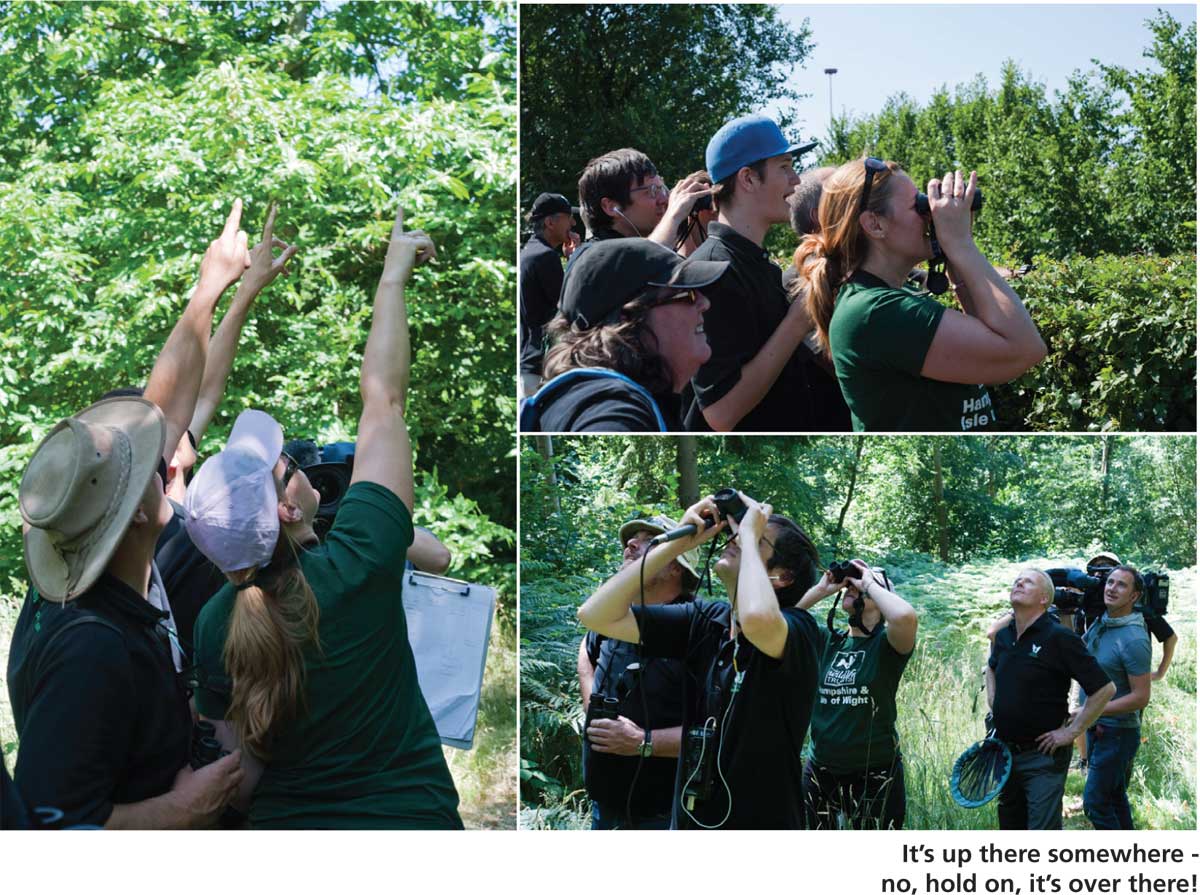Sussex's 'Wood Whites' WIN Eccentric Butterfly Race
Originally published in the Spring 2013 Sussex Butterfly Report
Naturalist Nick Baker was crowned 'Butterfly King of the South' at a ceremony on Bosham beach on Friday, 19th July 2013, after a keenly fought contest between his team, of Sussex BC members, and Hampshire's 'Glanville Fritillaries' led by Matthew Oates, butterfly expert for the National Trust.
The race was held to mark the start of the Big Butterfly Count, Butterfly Conservation's national campaign to encourage the public to count common species. The winning team was crowned by Margaret Paren, OBE, Chair of the South Downs National Park Authority, at a ceremony broadcast live on BBC South Today.
During the day each team followed separate and secret routes in the opposing team's home county, dependent on the weather and known flight periods of different butterfly species. In their South Downs National Park Authority Land Rovers, each team worked with an adjudicator from the respective County Wildlife Trusts, to ensure that no rules were broken - well not too many! Debbie Tan, CEO of the Hampshire and Isle of Wight Trust, refereed the Wood Whites, whilst the Glanville Fritillaries needed to satisfy the scrutiny of Tony Whitbread, CEO of the Sussex Wildlife Trust
Route planning for the Wood Whites was the brainchild of Neil Hulme. The route was only really finalised on the day but Neil had been thinking strategy for weeks, identifying spots where we were most likely to find the widest variety of species. Our first stop was at Browndown, the target species being the Grayling. We all knew that for Team Glanville Fritillary to bag a Grayling they would have to travel across to East Sussex and we had reasoned that they wouldn't do this because of time constraints. So Neil argued that spotting a Grayling early in the competition would be a good tactical score, likely to hit the other team hard, when they picked up on it via the live Twitter feed.
Early success was followed by a blow just outside the Lakeside offices in Cosham. Here our target was the elusive White-letter Hairstreak. One of the competition's rules was that there should be no entering of private land, so the team peered from the road trying to point out the chocolate 'Toblerone' shaped butterflies to Debbie our adjudicator. However, there was no luck to be had with the White-Letter hairstreak and, disappointedly, we travelled on to our next site rather than waste any more time.

As we pulled up on the layby at Broxhead Common, a Blue landed on a bramble flower. It was a Silver-studded Blue, one of the easiest sightings of the whole day. This was the target species for the site and so we then prepared to drive off but just as we were about to leave a Small Heath flew by. This was becoming just too easy.
Our next stop was Goose Green, Alice Holt Forest, and our target His Imperial Majesty, the Purple Emperor. We were in a glade, which had one tall tree growing in the middle of it. This tree obscured one's line of sight, no matter where you positioned yourself in the glade. Things were getting a little desperate and every time a member of the team shouted out “Purple Emperor” Debbie would run to the side from which the call had come, only to find that she was too late to see the insect. This carried on for a good 25 minutes but eventually she saw the butterfly, not a good view but good enough to score the point. We had bagged His Majesty!
Moving on to Straits Enclosure, Alice Holt Forest we were lucky enough to see another, which came to rest above our head in a sallow tree overhanging the ride. The team quickly gathered around and we all stood in awe for some time, gaining fabulous views of the butterfly. For several in the party this was the first time in their lives that they had seen a Purple Emperor. I distinctly remember Nick Baker say, “It's like looking at a living stained glass window”, as he gazed in wonderment.
En route to Old Winchester Hill, we made an unplanned stop at a pub on the A32, not for a drink but to inspect their nasturtium filled hanging baskets. Here the team found both Small and Large White eggs, another two easy but critical early-stage bonus points.

Our visit to Old Winchester Hill was brief in the extreme, we went there for the Darkgreen fritillary, which we spotted almost instantaneously. For a while we walked aimlessly on the chalk grassland slopes, admiring the view, before realising that we were better off returning to Cosham. Here we aimed to see if we could get the one that had got away, at that point our only failure to find a target species, the White-letter Hairstreak. And find it we did, dancing for all to see, above the Elms we were watching.
We then decided to go to Paulsgrove Quarry because it was relatively near to our current location and it presented the distinct possibility of finding the Small Blue larvae that we so desperately needed. Eventually, after a couple of false alarms, Martin Warren discovered what we were looking for, the Small Blue caterpillar. Perhaps not the prettiest caterpillar to be seen but it was a stunningly good find, adding a new species to our list and an extra point because it was an early stage.
As Neil Hulme said later 'Not least, I will remember the day for the camaraderie and good spirits in which the teams competed. Lynn Fomison of Team Glanville even presented Team Wood White with one of her famous cakes. This is typical of the butterflywatching community'.
Nobody was able to ignore the fact that the butterflies had put on a spectacular show at a time when butterflying really hasn't been this good for many a year. And, of course, the plight of our butterflies received much-needed publicity as a result!
'Everyone's had a blast today' said Nick. 'It's been absolutely great. It's really important to track butterflies. It's good for the soul and being aware of what butterflies are doing, how they're doing and where they are gives us so many clues about the state of the countryside'.
Both teams scored the same total of 34 points, but the adjudicators awarded the crown to the team from Sussex as they counted 28 species, 2 more than their opponents.


